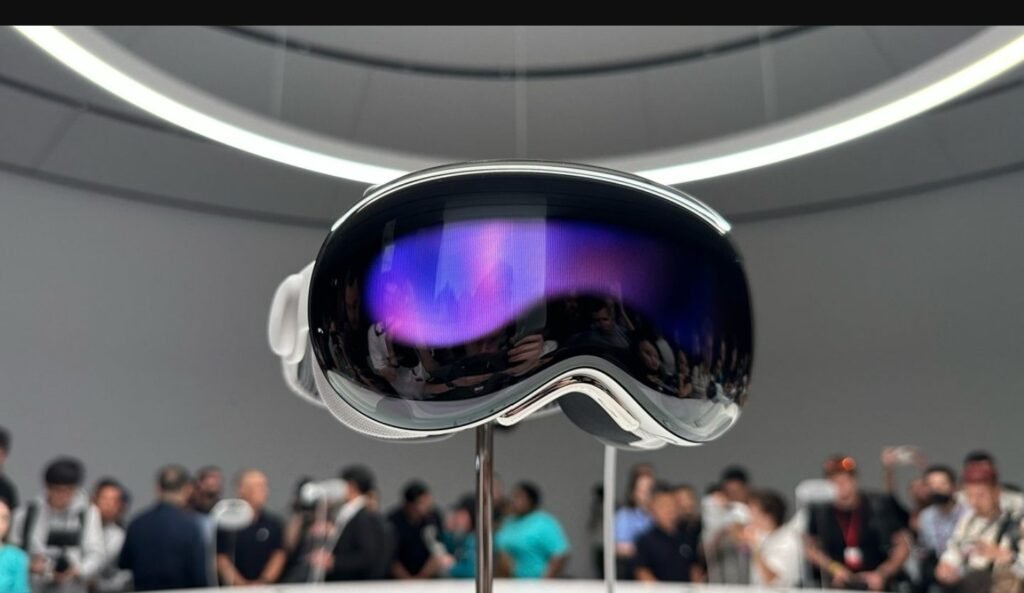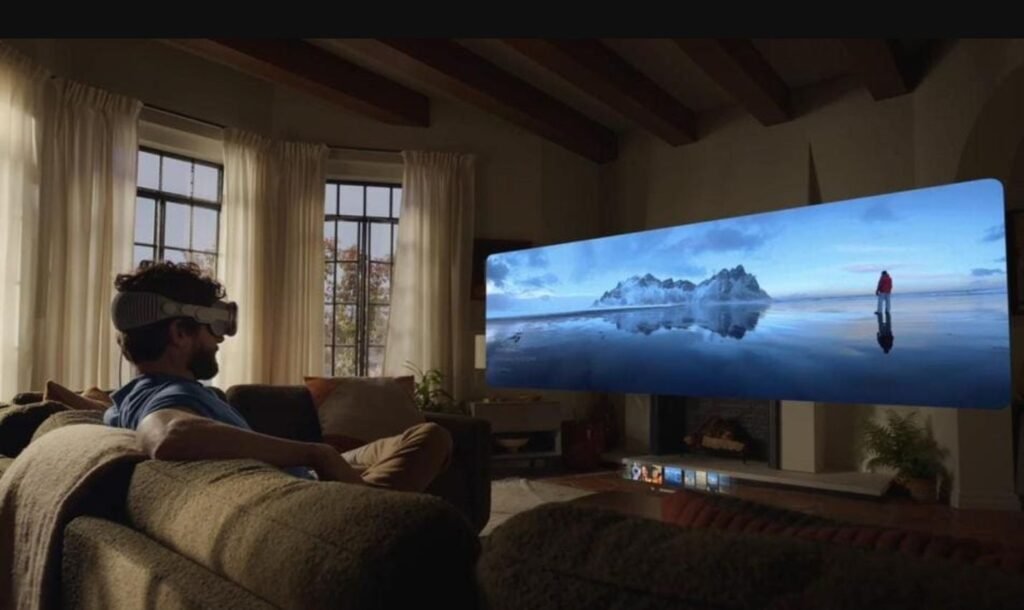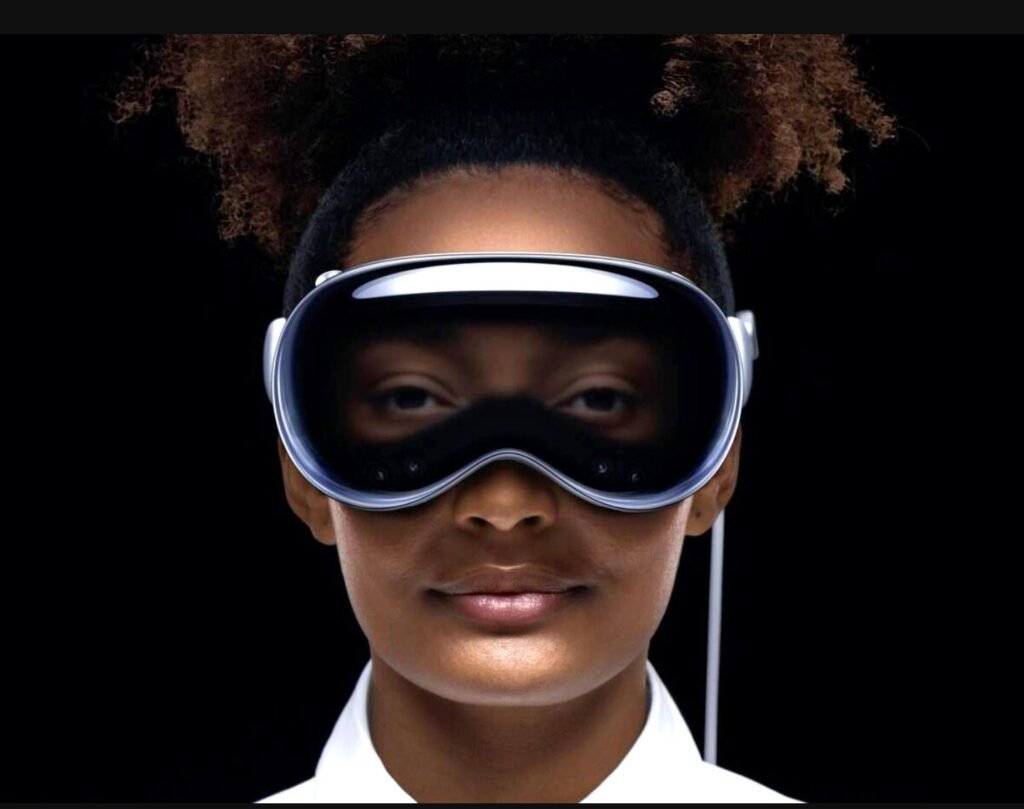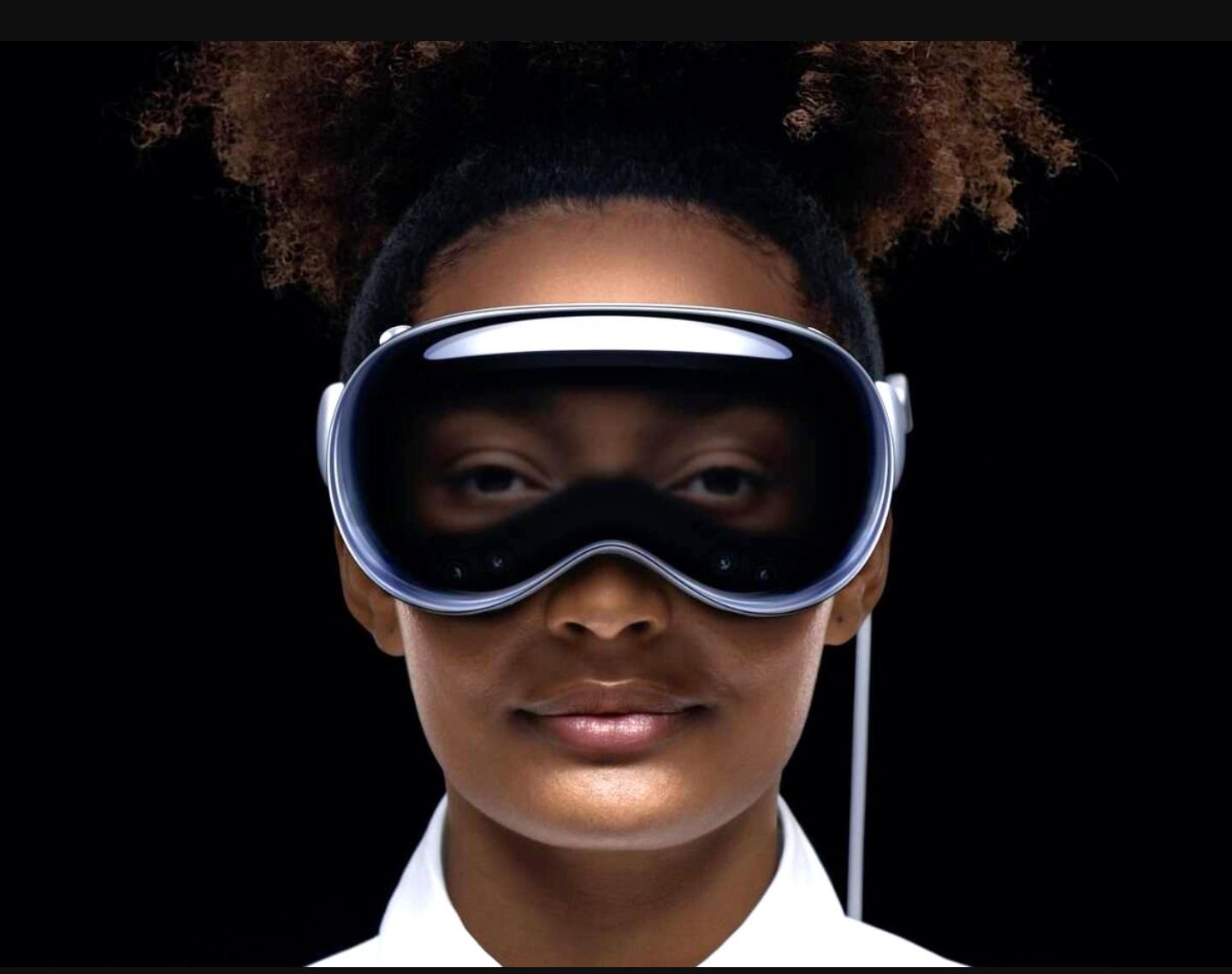Apple Vision Pro is a new AR/VR headset from Apple that was announced on February 13, 2024. It is the company’s first foray into the AR/VR market, and it is expected to be a major competitor to other headsets like the Meta Quest 2 and the HTC Vive Pro 2.

The Apple Vision Pro is a high-end headset that is packed with features. It has a high-resolution display, a powerful processor, and a variety of sensors that allow it to track the user’s movement and environment. The headset also has a built-in camera that can be used to capture photos and videos in 3D.
The Apple Vision Pro is designed to be used for a variety of activities, including gaming, watching movies, and working. It can also be used for educational purposes, such as taking virtual field trips or learning about different subjects in an immersive way.
The Apple Vision Pro is not cheap. It is priced at $3,500 in the United States, and it is expected to be priced similarly in other countries. However, it is still significantly cheaper than other high-end AR/VR headsets, such as the HTC Vive Pro 2, which costs $799.
The Apple Vision Pro is expected to be released in the United States in the spring of 2024. It is not yet clear when it will be released in other countries.
Here are some of the key features of the Apple Vision Pro:

- High-resolution display: The Apple Vision Pro has a high-resolution display that provides a sharp and clear image. The display has a resolution of 23 million pixels, which is significantly higher than the resolution of other AR/VR headsets.
- Powerful processor: The Apple Vision Pro is powered by the Apple R1 chip, which is a custom-designed chip that is specifically optimized for AR/VR applications. The R1 chip is said to be twice as powerful as the A15 Bionic chip that is found in the iPhone 13 Pro.
- Variety of sensors: The Apple Vision Pro has a variety of sensors that allow it to track the user’s movement and environment. These sensors include two high-resolution main cameras, six world-facing tracking cameras, four eye-tracking cameras, a TrueDepth camera, a LiDAR scanner, and four IMUs.
- Built-in camera: The Apple Vision Pro has a built-in camera that can be used to capture photos and videos in 3D. The camera has a resolution of 12 megapixels, and it can record video at up to 8K resolution.
The Apple Vision Pro is a significant development in the AR/VR market. It is a high-end headset that is packed with features, and it is expected to be a major competitor to other headsets like the Meta Quest 2 and the HTC Vive Pro 2.
Known information:
- Price: Starts at $3,500 (approximately ₹2.8 lakhs in India)
- Features: high
- high-resolution display, powerful processor, variety of sensors for tracking and eye tracking, and a built-in camera for 3D photos and videos.
- Target audience: high-end consumers interested in AR/VR gaming, entertainment, and work applications.
- Release date: Spring 2024 in the US (no confirmed date for India)
Uncertain information:
- Specific release dates in India: It’s unclear when or if the Vision Pro will be officially launched in India.
- Availability of different storage options: The initial announcement only mentioned the 256GB version.
- Prescription lens options and pricing: whether prescription lenses will be available and their cost is unknown.
- App and content ecosystem: What apps and games will be available at launch and how extensive the ecosystem will be is yet to be seen.
- Design: The Apple Vision Pro is a headset that is worn over the head and covers the user’s eyes. It has a sleek and minimalist design, similar to other Apple products. The headset is made of high-quality materials, such as metal and plastic, and it feels comfortable to wear.Apple Vision Pro headset
- Display: The Apple Vision Pro has a high-resolution display that provides a sharp and clear image. The display has a resolution of 23 million pixels, which is significantly higher than the resolution of other AR/VR headsets. This means that users will be able to see text, images, and videos in stunning detail.
- Processor: The Apple Vision Pro is powered by the Apple R1 chip, which is a custom-designed chip that is specifically optimized for AR/VR applications. The R1 chip is said to be twice as powerful as the A15 Bionic chip that is found in the iPhone 13 Pro. This means that the Vision Pro will be able to handle demanding tasks, such as running complex games and applications, without any problems.
- Sensors: The Apple Vision Pro has a variety of sensors that allow it to track the user’s movement and environment. These sensors include two high-resolution main cameras, six world-facing tracking cameras, four eye-tracking cameras, a TrueDepth camera, a LiDAR scanner, and four IMUs. These sensors work together to create a detailed map of the user’s surroundings and to track their movements with precision. This allows for a more immersive and realistic AR/VR experience.
- Built-in camera: The Apple Vision Pro has a built-in camera that can be used to capture photos and videos in 3D. The camera has a resolution of 12 megapixels.
Apple Vision Pro, announced on February 13, 2024, marks Apple’s highly anticipated entry into the augmented reality (AR) and virtual reality (VR) headset markets. Positioned as a significant competitor to existing devices such as the Meta Quest 2 and the HTC Vive Pro 2, the Apple Vision Pro is expected to bring a blend of innovative features, sleek design, and seamless integration with Apple’s ecosystem.
While detailed specifications and features of the Apple Vision Pro are yet to be fully disclosed, anticipation surrounds its potential to leverage Apple’s prowess in hardware and software integration to deliver a compelling user experience. With Apple’s track record of pushing boundaries in consumer technology, the Vision Pro is likely to incorporate advanced AR capabilities, immersive VR experiences, and intuitive user interfaces.
The announcement of the Apple Vision Pro underscores the growing importance of AR and VR technologies in the consumer electronics landscape and sets the stage for intense competition among industry players. As consumers eagerly await more information about this new device, speculation abounds regarding its potential impact on the broader AR/VR market and its implications for the future of computing and digital interaction.

- Advanced Display Technology: Apple is known for its high-quality displays, and the Vision Pro is expected to feature advanced display technology to provide users with crisp visuals and immersive experiences. This might include high-resolution screens, a wide field of view (FOV), and possibly even technologies like MicroLED for improved brightness and efficiency.
- Powerful Hardware: Given Apple’s expertise in designing powerful hardware, the Vision Pro is likely to be equipped with a robust chipset optimized for AR/VR applications. This could result in smooth performance, fast loading times, and support for demanding graphics.
- Innovative Sensors and Tracking: The Vision Pro may incorporate sophisticated sensors and tracking systems to accurately map the user’s environment and enable precise motion tracking. This could enhance the realism of AR experiences and improve the accuracy of interactions in VR environments.
- Integration with the Apple Ecosystem: One of Apple’s strengths is its ecosystem of devices and services. The Vision Pro is expected to seamlessly integrate with other Apple products, allowing users to access content, notifications, and applications across their devices.
- Comfort and Design: Apple places a strong emphasis on design and the user experience. The Vision Pro may feature a sleek and ergonomic design, with comfort-focused elements such as adjustable straps, lightweight materials, and breathable padding for extended use.
- Software and Content: Apple is likely to invest in building a robust ecosystem of AR and VR content for the Vision Pro. This may include partnerships with developers to create immersive apps, games, and experiences tailored for the headset.
- Privacy and Security: As with all Apple products, privacy and security are likely to be key considerations for the Vision Pro. Apple may implement features such as user-controlled data sharing, secure authentication methods, and robust privacy protections to safeguard user information.
- Developer Support: Apple is known for its developer-friendly ecosystem, and the success of the Vision Pro may hinge on the support it receives from developers. Apple is likely to provide robust tools and resources for developers to create innovative AR and VR experiences for the headset. This could lead to a thriving ecosystem of apps, games, and utilities that enhance the value proposition of the device.
- Health and Wellness Features: Given the increasing focus on health and wellness in consumer technology, the Vision Pro may incorporate features aimed at promoting user well-being during AR/VR experiences. This could include features such as built-in eye tracking for monitoring eye strain, adaptive refresh rates to reduce motion sickness, and integrations with health tracking apps to monitor physical activity.
- Enterprise Applications: While consumer adoption is expected to be significant, the Vision Pro may also find traction in enterprise settings. Apple may position the headset as a productivity tool for industries such as design, engineering, healthcare, and education, where AR/VR technologies can enhance collaboration, training, visualization, and simulation.
- Accessibility Features: Accessibility is a core principle for Apple, and the Vision Pro is likely to include a range of accessibility features to make AR and VR experiences more inclusive. This could include options for customizable interfaces, voice commands, gesture controls, and support for assistive technologies such as screen readers and haptic feedback.
- Ecosystem Lock-In and Interoperability: While seamless integration with the Apple ecosystem is a selling point for many consumers, there may also be concerns about ecosystem lock-in and interoperability with non-Apple devices and platforms. Apple’s approach to interoperability and its openness to third-party integrations will influence the device’s appeal to a wider audience.
- Price and Market Positioning: The pricing strategy for the Vision Pro will play a crucial role in its adoption and market competitiveness. Apple may opt for a premium pricing strategy, positioning the device as a high-end AR/VR solution with premium features and build quality. However, striking the right balance between price and value will be essential to attracting a broad range of consumers.
- Regulatory and Ethical Considerations: As with any emerging technology, the Vision Pro may raise regulatory and ethical considerations related to privacy, data security, content moderation, and user safety. Apple’s approach to addressing these concerns and its commitment to responsible innovation will shape perceptions of the device in the marketplace.
Overall, the Apple Vision Pro represents a significant step forward for AR/VR technology, and its impact on the market will depend on a variety of factors, including its features, performance, ecosystem support, pricing, and broader societal implications. As the device is unveiled and enters the market, it will be fascinating to see how it shapes the future of immersive computing experiences.

